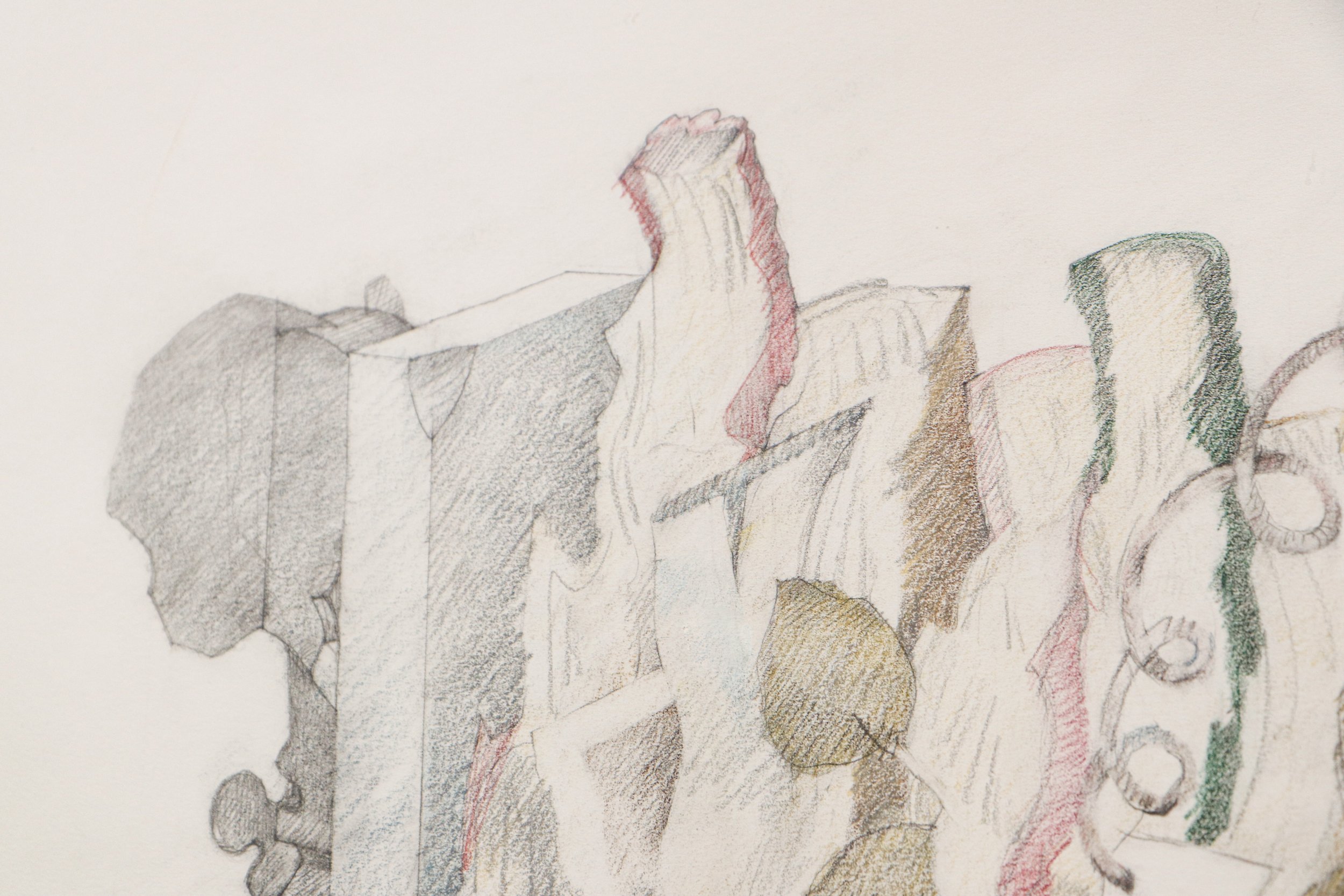Claes Oldenburg
From the Entropic Library (Final Study), 1989
Colored pencils and pencil on paper
29.5 X 39.5 inches
75 X 100.3 cm
Signed and dated '89 lower center
ABOUT THE WORK
Claes Oldenburg's From the Entropic Library (Final Study), 1989, is the final preparatory drawing for the sculpture From the Entropic Library, created in collaboration with his wife and creative partner, Coosje van Bruggen. The sculpture was first shown in 1989 at the Magiciens de la Terre exhibition at the Centre Pompidou in Paris and has since appeared in several international galleries and museums. According to the artists, the work “expresses the inevitable fragility of technology and human culture in the face of the processes of nature.” The work reflects Oldenburg's ongoing interest in time, decay, and explores themes of memory, transformation, and loss.
Oldenburg, famous for his large-scale sculptures of everyday objects, was meticulous in his creative process, relying heavily on preparatory drawings to refine his ideas – From the Entropic Library is no exception. The colored pencil final study shows a row of decaying books, propped between two bookends. The bookends, which fuse elephant heads with outboard motors, symbolize the erosion of "book learning" and the transient and evolving nature of knowledge. Torn pages and illegible writing scattered around the scene further emphasize the idea that knowledge, like physical objects, deteriorates over time.
Oldenburg and van Bruggen’s sculpture was conceived for the Magiciens de la Terre: an exhibition that sought to challenge and criticize the Eurocentric concept of "primitive art" by showcasing global works. Van Bruggen developed a fictional backstory to complement the sculpture:
A European explorer builds a library in the wilderness, complete with books, notes, and a single electric light. Over time, the library is abandoned and overtaken by nature, symbolizing the collapse of European knowledge and technology in the face of natural forces. The crumbling books, overtaken by time and nature, demonstrates the violence of nature’s dominance over human knowledge and culture.
Oldenburg and van Bruggen demonstrate how European materiality and culture is impermanent compared to the inevitability of nature. The two flattened bunches of greenery sticking out between the books, possibly collected by van Bruggen’s imaginary explorer, continues the narrative of an explorer seeking to leave his mark on the natural world – but his act of hubris proves futile.
Cognizant of the repercussions of European technology and industrialization upon the African continent, Oldenburg contrasts the “modernism” of European civilization with the “primitivism” of African civilization through the fusion of two elements: the elephant head and the outboard motor. The elephant, a recurring symbol in Oldenburg’s work, represents the African continent, and underscores a history of colonization and exploitation. The outboard motor, representing European industrialization and exploration, highlights the colonial push into Africa's interior. Oldenburg juxtaposes technology and nature; together, these elements critique European technological domination while demonstrating the resilience of nature over human intervention.
In addition to its other themes, the work delves into the concept of memory. The elephant’s "long memory" is distinguished from humanity's reliance on books to preserve knowledge – an ultimately doomed effort, as books deteriorate and lose their meaning. Art historian Dieter Koepplin makes this comparison in his essay “From the Entropic Library” in Claes Oldenburg: An Anthology, noting that "an elephant's memory is notorious, while human memory—at least, historical memory—is best preserved in books and titles" (478). As the books slowly collapse, they embody cultural amnesia, symbolizing the fading of accumulated wisdom into incomprehensibility. For Oldenburg, gravity—his "favorite creative force of form"—plays a pivotal role in the piece, creating a sense of inevitable collapse and decomposition that mirrors the natural process of decline.
From the Entropic Library critiques European colonialism and meditates on the fragility of culture, the inevitable decay of material objects, and the dominance of nature. The Final Study not only captures Oldenburg’s masterful drawing skills but also his intricate vision for a sculpture that probes human memory and civilization’s tenuous hold on knowledge.









